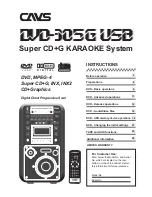
17
MAINTENANCE MANUAL MODELS 825Y, 825YA, 825, 825D, 825YD & 826YD
Service Procedures 825, 825D, 825YD and 826YD
(2
1
/
2
–3") (Continued)
3b. Valve Seat Removal (Sizes 2½
–3") Bolted in
Seat Ring Type Models 825D & 825YD
(See Figure No. 14)
1.
Remove the three capscrews and washers
retaining the seat ring.
2.
Pull the seat ring from the valve body being
careful not to damage the internal epoxy coating of valve.
3.
If necessary, un-thread the bushing (Item 2A) from the seat
ring.
4.
Remove the o-ring.
4a. Valve Seat Reassembly (Sizes 2½
–3')
Threaded-in Seat Ring Type Models
Model 825 (See Figure No. 13)
1.
Lubricate o-ring with FDA approved lubricant and replace on
seat ring.
2.
Reinsert bushing into seat ring center.
3.
Thread seat ring into valve body in clockwise direction being
careful not to damage the internal epoxy coating of valve.
4b. Valve Seat Reassembly (Sizes 2½
–3")
Bolted-in Seat Ring Type Models
Model 825D & 825YD (See Figure No. 14)
1.
Lubricate o-ring with FDA approved lubricant and replace in
seat ring.
2.
Thread bushing into seat ring.
3.
Place the seat ring carefully into body and retain with three
capscrews and washers being careful not to damage the
internal epoxy coating of valve.
5. Check Valve Reassembly (Sizes 2½
–3")
(See Figures No. 15 & 16)
a.
Position the disc in the cleaned holder and retain with disc
washer. Insert stem into disc holder, replace the nut on
stem and tighten.
NOTE: On older Model 825 valves, the disc holder is sealed
to the stem with a sealant. If the seal is broken, the stem
and holder must be cleaned and new sealant applied. Newer
valves, Models 825D and 825YD, use an o-ring so a sealant is
not required.
b.
Thread bushing into cover.
c.
Carefully place stem of check assembly into seat ring bush-
ing. Replace spring centering diameter on the disc washer.
NOTE: Be sure the heavier spring (6 psi) is placed in first check
and lighter spring (2 psi) is placed in second check or the unit
will not operate properly and discharge from the relief valve
could occur. The wire diameter is visibly thicker on the heavier
spring and thinner on the lighter spring. Care should be taken
to avoid damaging internal epoxy coating of valve.
d.
Place cover on check body securing spring and stem into
cover.
e.
Bolt cover onto check body while holding cover in place
with appropriate hand force. Spring will be retained in body
by cover.
f.
Slowly open inlet shutoff valve. Bleed air from valve by
opening first the # 4 test cock, then the
# 3, # 2 and # 1 test cocks and air bleeds on all
covers. See Figure No. 8 for test cock locations.
g.
Slowly open outlet shutoff valve and return the valve to ser-
vice.
h.
Test the assembly to ensure it is operating properly.
















































